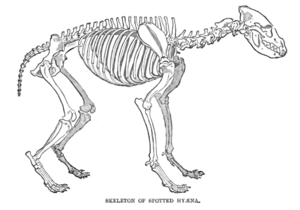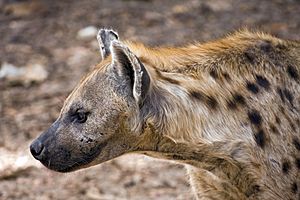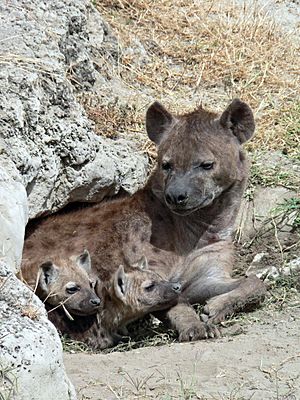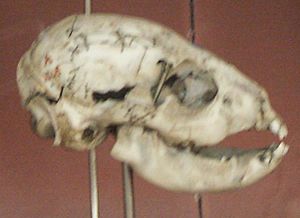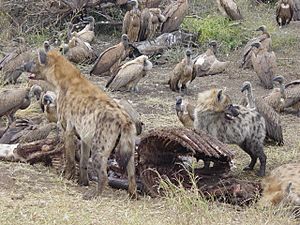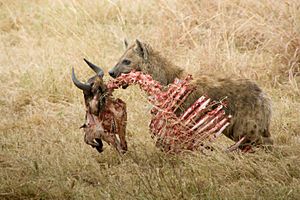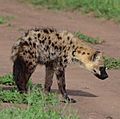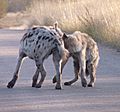Spotted hyena facts for kids
Quick facts for kids Spotted hyenaTemporal range: late Pliocene – Recent
|
|
|---|---|
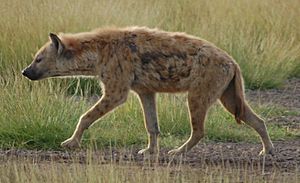 |
|
| Spotted hyena in Amboseli National Park, Kenya | |
| Conservation status | |
| Scientific classification | |
| Kingdom: | |
| Phylum: | |
| Class: | |
| Order: | |
| Family: | |
| Genus: |
Crocuta
|
| Binomial name | |
| Crocuta crocuta (Erxleben, 1777)
|
|
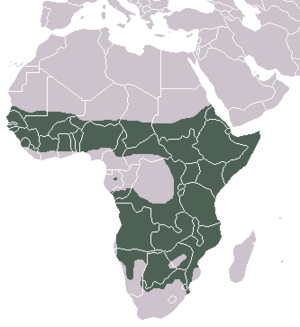 |
|
| Spotted hyena range | |
The spotted hyena (Crocuta crocuta), also known as the laughing hyena, is a meat-eating mammal. It belongs to the Hyaenidae family, and it's the biggest member of this group alive today. Even though they used to live across Eurasia, from Europe to China, they are now only found in Africa south of the Sahara Desert, except for the Congo Basin. Spotted hyenas live in large groups called clans. These clans can have up to 80 members and are led by females, meaning they are matriarchal.
Many people think spotted hyenas are just cowardly scavengers, but they actually hunt most of their food. They mainly hunt medium-sized animals with hooves, like ungulates. They often fight with lions over food and land. Spotted hyenas are very smart among carnivora, and some studies show their social intelligence is similar to that of some primates.
Spotted hyenas are important in African myths and stories. Sometimes they are seen as bringing light, and other times as a sign of bad things.
Contents
About Spotted Hyenas
Spotted hyenas are the largest type of hyena alive today. Their fur is shorter than that of striped hyenas, and they have less bushy manes. They have very strong front legs and necks, similar to leopards, but their back legs are smaller. Their rear end is rounded, which makes it harder for other animals to grab them if they are being chased. Female spotted hyenas are bigger than males, weighing about 12% more.
Adult spotted hyenas are usually 95 to 165 cm long and stand 70 to 91 cm tall at the shoulder. In the Serengeti, males weigh about 40 to 55 kg, while females weigh 44 to 63 kg. Hyenas in Zambia can be even heavier.
Spotted hyenas have incredibly strong jaws. They can crush the long bones of giraffes, which are about 7 cm wide! They also have excellent night vision, helping them see each other even in total darkness.
Behavior and Habits
Spotted hyenas often rest and give birth in dens. They usually don't dig these dens themselves. Instead, they use old burrows made by animals like warthogs, springhares, or jackals. One den can be home to several female hyenas and many cubs at the same time. Unlike grey wolves, spotted hyenas often let cubs from different mothers stay in the same den.
Sometimes, spotted hyenas live close to warthogs, even sharing mud holes or sleeping just a few meters apart. If the weather isn't too hot, they might sleep out in the open. Otherwise, they rest near water or in thick bushes. Even though they live in groups, spotted hyenas sometimes go out to find food alone, but they always return to their clan.
Like other hyenas, spotted hyenas have special scent glands near their rear end. These glands produce a white paste with a strong, soapy smell that even humans can notice. They spread this paste on grass stalks for many reasons, like when they are walking alone, near a kill, when lions are around, or most often, at the edges of their territory. After scent-marking, they often scratch the ground with their front paws, adding more scent from glands in their feet.
Social Life
Spotted hyenas are more social than grey wolves, but their groups are not as tightly connected as African wild dogs. Spotted hyena societies are very complex, much like those of some monkeys. They have similar group sizes, structures, and ways of competing and cooperating.
Like monkeys, spotted hyenas use many senses to understand each other. They can recognize individual hyenas and know which clan members are more reliable. They also understand family relationships and social ranks within their clan. They use this knowledge to make decisions in their social lives. In hyena societies, being dominant isn't about size or how aggressive an individual is. Instead, it's about who has the most allies. A hyena clan can have anywhere from 5 to 90 members and is led by a single main female, called the matriarch.
Reproduction and Life Cycle
Spotted hyenas can have babies at any time of the year, though more births happen during the wet season. Usually, a mother has two cubs, but sometimes three. Male hyenas do not help raise the young. Pregnancy usually lasts about 110 days.
Cubs are born with soft, brownish-black fur and weigh about 1.5 kg. What's special about spotted hyena cubs is that they are born with their eyes open and with small canine teeth already grown. Right after birth, cubs will often attack each other. This is especially true for cubs of the same sex and can sometimes lead to the death of the weaker cub. Mothers are very protective of their cubs and won't let other adult hyenas, especially males, come near them.
Spotted hyena cubs learn adult behaviors very early. They have been seen sniffing each other and marking their territory before they are even a month old. Within ten days of being born, they can move quite fast. They start to lose their black fur and get the spotted, lighter fur of adults when they are two to three months old. Cubs begin to practice hunting at eight months and fully join group hunts after their first year.
Female hyenas can carry a lot of milk for their cubs. Spotted hyena milk is very rich in protein and fat. This means mothers can leave their cubs for about a week without feeding them, unlike lions or wild dogs. Cubs will drink their mother's milk for 12 to 16 months, but they can start eating solid food as early as three months old.
In zoos, spotted hyenas usually live for about 12 years, but some can live up to 25 years.
What They Eat
Spotted hyenas are very good at eating leftovers from other animals' kills. They can break and eat even the largest bones of animals with hooves, and they can digest them completely. They digest all the parts of bones, not just the soft inside. Any parts they can't digest come out in their poop, which looks like white powder with a few hairs.
They pay more attention to vultures landing than other African meat-eaters. They are also more likely to stay near where lions have made a kill or near human homes. In places like Ngorongoro and the Serengeti, wildebeest are their most common prey. Zebras and Thomson's gazelles are also often hunted. They rarely attack Cape buffalo because they live in different areas, but adult male buffalo have been caught sometimes.
Spotted hyenas have also been seen catching fish, tortoises, and even young humans. They can also hunt black rhino calves, hippo calves, young African elephants, pangolins, and pythons. They eat many different types of animals with hooves.
A single spotted hyena can eat at least 14.5 kg of meat in one meal. Even though they can be aggressive with each other while eating, they mostly compete by eating faster, not by fighting like lions do. When they find a whole animal, they first eat the meat around the hips and rear. Then they open the belly and pull out the soft organs. After eating the stomach and its contents, they eat the lungs and leg muscles. Once the muscles are gone, they break the carcass apart and carry pieces away to eat in peace. Spotted hyenas are good at eating prey in water; they have been seen diving under floating bodies to take bites, then coming up to swallow. One hyena can eat a gazelle fawn in less than two minutes. A group of 35 hyenas can completely eat an adult zebra in just 36 minutes! Spotted hyenas don't need much water and usually drink for only about 30 seconds.
Hunting Behavior
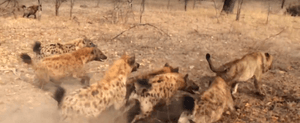
Unlike other large African meat-eaters, spotted hyenas don't prefer to hunt any one specific animal. They mostly avoid buffalo, giraffe, and plains zebra. Spotted hyenas prefer to hunt animals that weigh between 56 and 182 kg, with 102 kg being the most common weight. When hunting medium to large prey, spotted hyenas often choose young or old animals. However, they don't target old zebras as much because zebras are very good at defending themselves. Unlike grey wolves, spotted hyenas use their sight more than their smell when hunting. They don't follow footprints or walk in a single line.
Spotted hyenas usually hunt wildebeest alone or in groups of two or three. They often catch adult wildebeest after chasing them for about 5 km at speeds up to 60 km/h. One hyena usually starts the chase. Except for mothers with calves, wildebeest herds don't usually try to fight back much. Sometimes, wildebeest try to escape hyenas by going into water, but the hyenas almost always catch them there.
Zebras need different hunting methods because they run in tight groups and male zebras (stallions) defend them aggressively. Hyenas seem to plan their zebra hunts ahead of time. They might do things like scent-marking before they start, which they don't do for other prey. Typical zebra hunting groups have 10 to 25 hyenas. During a chase, zebras usually run in close groups, with the hyenas chasing behind them in a crescent shape. These chases are usually slower, around 15 to 30 km/h. A stallion will try to stay between the hyenas and the herd. But once a zebra falls behind the group, it is quickly attacked, usually after a 3 km chase. Even though hyenas might bother the stallion, they usually focus on the herd and try to avoid the stallion's attacks. Unlike wildebeest, zebras rarely go into water to escape hyenas. Once prey is caught, spotted hyenas kill their prey by eating it alive.
Spotted hyenas hunt more often when their prey animals are having babies, or when other predators often steal their kills.
Images for kids
-
Skull of Crocuta sivalensis, an extinct hyena from India
-
Close-up of a female hyena's head in Kruger National Park
-
Female hyena nursing her cub in Amboseli National Park, Kenya
-
Three cubs in the Kruger National Park in South Africa
-
Spotted hyena facing African wild dogs in Sabi Sand Game Reserve
-
Spotted hyenas greeting each other in Kruger National Park
-
Spotted hyena mask from Burkina Faso
-
Spotted hyena being attacked by Maasai warriors
-
A trained hyena in Nigeria
See also
 In Spanish: Hiena manchada para niños
In Spanish: Hiena manchada para niños



